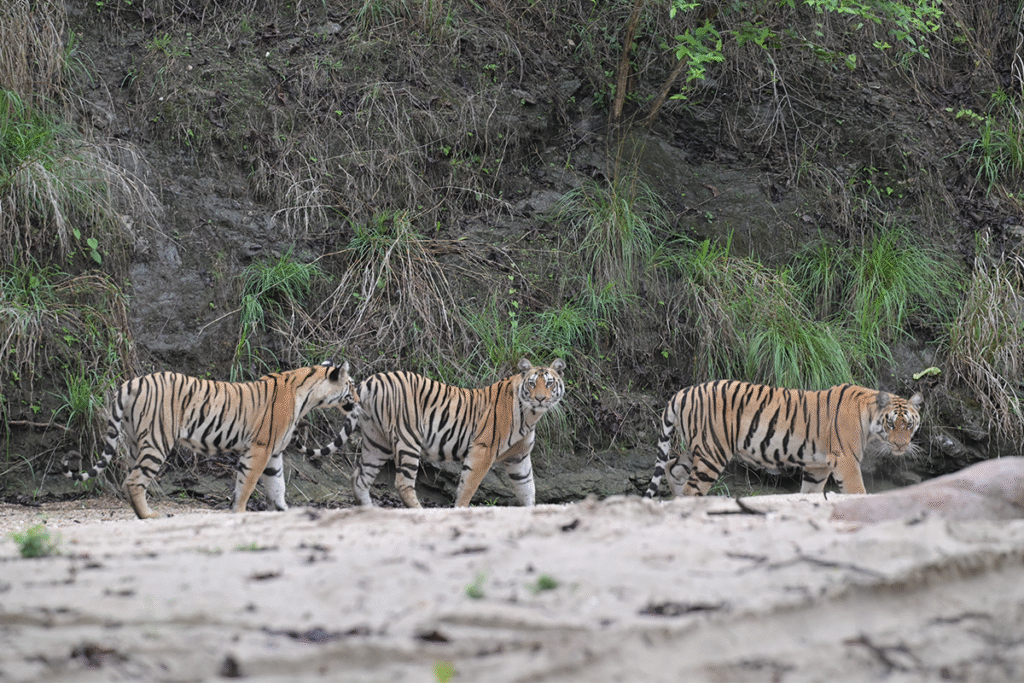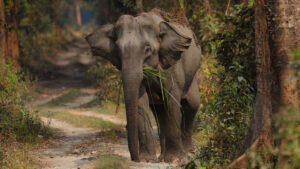Top 10 Wildlife Sanctuaries in India: Explore the Wild Like Never Before
Megha

You know! India is a land of ecological wonders…How many of you reading this blog knows that India is one of the 17 megadiverse count tries in the world. That’s really huge!
India’s biodiversity is incredibly varies and has become globally significant with over 100,000 species of animals and around 47,000 species of plants. India is a land of incredible biodiversity, home to lush forests, majestic mountains, and diverse ecosystems. Wildlife Sanctuaries in India help protect endangered species and preserve natural habitats.
We all know that rapid urbanisation is happening in our country and our wildlife sanctuaries are not just tourist attractions. Due to this evolution, they have become the lifelines for biodiversity. The best wildlife sanctuary in India has become the guardians of ecological resilience.
We believe conservation is a crucial thing for protecting our mother Earth and the delicate ecosystems embedded in it. The national parks and sanctuaries in India must be protected to safeguard the endangered species, natural habitats, and the ecological balance. Our conservation system should support agriculture, clean air, water cycles and climate stability to enjoy the tourism.
Let’s see some bigger picture in this blog!
We believe conservation and eco-tourism will create a powerful cycle that will create opportunities for travellers to connect with the nature in a more peaceful manner. The national parks and sanctuaries in India can be visited by supporting the local communities and promoting education with awareness.
What is a Wildlife Sanctuary?
A wildlife sanctuary in India is a protected area where animals live in their natural habitat without human interference. Unlike national parks, which have stricter regulations, sanctuaries allow certain human activities under controlled conditions.
Before you visit any of the best wildlife sanctuary in India, you have to know the difference between wildlife sanctuary, national park and biosphere reserve.
| Feature | Wildlife Sanctuary | National Park | Biosphere Reserve |
| Purpose | Conservation of specific species and habitat. | Preservation of ecosystems and biodiversity | Integrated approach to conservation, research, and sustainable development. |
| Human Activity | Permitted to some extent (e.g., grazing, tribal rights). | Not permitted; no human activities allowed inside the core zone. | Zonation allows core (protected), buffer (limited use), and transition (sustainable use) zones |
| Legal protection | Protected under the Wildlife Protection Act, 1972. | More strictly protected under the same act. | Designated under the Man and Biosphere Programme (UNESCO) and Indian government initiatives. |
Top 10 Wildlife Sanctuaries in India
1. Jim Corbett National Park, Uttarakhand
Nestled in Uttarakhand’s Nainital district, Jim Corbett National Park is India’s oldest and one of the most famous wildlife sanctuaries in India. The best time to visit is between November to June.
2. Ranthambore National Park, Rajasthan
Located in Sawai Madhopur, Ranthambore National Park is a prime wildlife sanctuary in India known for its Royal Bengal tigers, sloth bears, and marsh crocodiles. The park’s ancient ruins add a historic charm to tiger safaris. Visit between October and June for the best wildlife sightings.
3. Kaziranga National Park, Assam
A UNESCO World Heritage Site, Kaziranga National Park in Assam is the stronghold of the endangered one-horned rhinoceros, buffaloes and tigers. The ideal visiting period is November to April.
4. Bandhavgarh National Park, Madhya Pradesh
With one of the highest tiger densities in India, Bandhavgarh National Park in Madhya Pradesh is a paradise for wildlife lovers. Besides tigers, the park shelters leopards and deer species. Visit between October and June.
5. Sundarbans National Park, West Bengal
The Sundarbans, a UNESCO-listed mangrove forest, is home to the elusive Royal Bengal tigers, saltwater crocodiles, and rare birds. Explore this unique ecosystem via boat safaris from September to March.
6. Periyar Wildlife Sanctuary, Kerala
Set in Kerala’s Thekkady region, Periyar Wildlife Sanctuary is famed for its elephants, tigers, and exotic birdlife. The best time to visit is September to April, with activities like boat cruises on Periyar Lake and bamboo rafting.
7. Gir National Park, Gujarat
The only home of the Asiatic lions, Gir National Park in Gujarat also hosts leopards and antelopes. Plan your visit between December and March for lion safaris and scenic nature trails.
8. Kanha National Park, Madhya Pradesh
Inspiration for Rudyard Kipling’s The Jungle Book, Kanha National Park boasts tigers, barasingha (swamp deer), and wild dogs. The ideal visiting window is October to June, with jeep safaris and birding opportunities.
Also check – Kanha National Park Holiday Packages
9. Manas National Park, Assam
A UNESCO Biosphere Reserve, Manas National Park shelters Bengal tigers, pygmy hogs, and golden langurs. Visit from November to April for elephant safaris and river rafting in the scenic Manas River.
10. Tadoba Andhari Tiger Reserve, Maharashtra
Known for its high tiger sightings, Tadoba Andhari Tiger Reserve in Maharashtra also hosts leopards and Indian gaurs. The best time to explore is October to June, with night safaris.
Also check – Tadoba Tiger Reserve Tour Packages
Best Wildlife Sanctuary in India: Jim Corbett National Park, India’s first national park, leads with unmatched biodiversity, while Kaziranga is a must-visit for its iconic one-horned rhinos.
Best wildlife sanctuary in India
If we say as the ‘BEST’ wildlife sanctuary in India, it brings a lot of essence to the term ‘BEST’. This isn’t about the size or popularity, rather depends on the ecological importance, conservation methods, and the visitor experience. The last one is more important, as people must have a very good time in the wildlife sanctuary in India with the species.
Let’s talk about few factors that makes you to choose one best wildlife sanctuary in India!
Biodiversity – This comprises of the endemic or any endangered species that is considered to be highly valuable. If the biodiversity is greater and richer, the ecological resilience will be high. Therefore, it brings a scientific importance to the national parks and sanctuaries in India.
Quick tip: If you have to choose one best wildlife sanctuary in India, then you have to make a note of the top 10 wildlife sanctuaries in India and then come to a conclusion. Our blog will help you to analyse better on this decision.
Efforts on the conservation – You have to check on the active participation of the government on conservative measures. This includes the community involvement, sustainability management, and other special acts for the long-term reputation of the wildlife sanctuary in India.
The best part…
Visitor experience – While talking about the visitor experience, you have to get an idea about the SAFETY measures involved in the wildlife sanctuary. This leads to a more ethical and immersive experience to connect with people.
And don’t forget…
Without harming the nature!
Research and education – You have to consider the fact that many top 10 wildlife sanctuaries in India has doubled as centers for ecological research, monitoring the species, educational aspects and influencing policies.
From our point of view, while considering the above discussed point of view, we come up with few options of the best wildlife sanctuary in India for you!
Jim Corbett National Park, Uttarakhand – This wildlife sanctuary in India is a flagship for tiger reservation under the Project Tiger. It has over 650 bird species, tigers and elephants. We can say that they have a well-managed safari, multiple eco-tourism initiatives and unique community management.
Kaziranga National Park, Assam – It has been considered as the UNESCO world heritage site with 2/3 of the world’s one-horned rhinoceroses. The most impressive part is they have shown high success rate in anti-poaching and rhino conservation compared to the other national parks and wildlife sanctuaries in India.
Tips for visiting wildlife sanctuaries:
Not just as tourist destinations anymore…
We are here to help you with some tips to consider before visiting the top 10 wildlife sanctuary in India. We enforce this culture to entertain a more respectful and safe visit for you and the wildlife in India.
First thing you have to do is;
Respect the wildlife and their space!
- We also have our own spaces at home and similarly, wildlife sanctuary in India is their home space to stay and enjoy. When we visit them, we have to maintain the respect and observe from a distance. You should never approach, touch or feed the animals there!
- Use binoculars or zoom lenses to get a closer look without harming them
- Don’t make loud noises, sudden movements and flashing lights onto the species
- Once you visit the best wildlife sanctuary in India, you will be taken on a designated trail and zones. You have to stick to the marked paths and don’t enter any restricted areas that will endanger both you and the species. Take the designated safari paths as directed by the concerned person.
- Photographs are the major activity that is done in national parks and wildlife sanctuaries in India, hence you have to be responsible while doing so. You should not bait or lure the animals for photos. Keep avoiding flashes on the species as some are nocturnal and sensitive around.
- We are humans! Hence, do not litter around the space. Always carry reusable water bottles and bags.
- The most importune thing is patience and being quiet. You have to keep in mind that the wildlife sightings in the best wildlife sanctuary in India often require silence and time. Hence, you have to be still and observant during the visit.
- Take smaller groups with you and make less noise in the wildlife sanctuary in India. You will have some certified naturalists and guides around to provide you more insights on the species and safety measures.
- You have to strictly avoid night time viewing to many sanctuaries unless it is official and regulated.
- Try to learn more about the rules and conservation challenges faced by the national parks and wildlife sanctuaries in India. This will enrich your experience with a better understanding.
Who is a responsible tourist?
Here comes a list of ethics a responsible tourist must follow:
1. Always respect nature
2. Don’t disturb their natural habitat
3. Support local communities
4. Avial eco-friendly transport
5. Do no harm to species
6. Follow the sanctuary rules
7. Share your knowledge
8. Carry reusable bottles
9. Avoid plastics
10. Minimise waste
Now, why it matters!
Many people think that national parks and wildlife sanctuaries in India are take it for granted and they are marketed only for tour
This is not the case…
Every individual has to follow the responsible tourism principles to preserve our fragile conservations. The best wildlife sanctuary in India has its own ethics to support sustainable livelihoods for local communities. We are here to leave footprints for our future generations who can experience the same wonder that we have now!
Don’t just see places, protect them too!
Conclusion
India’s wildlife sanctuaries offer thrilling adventures while promoting conservation. By visiting these national parks and sanctuaries in India, you contribute to protecting our planet’s incredible biodiversity.
Would you like to be more than a visitor?
Anybody can make a difference by making a responsible step they take. Every step you take contributed to the preservation of the wildlife sanctuary in India.
Make your visits more consciously and choose eco-certified tours. You can donate or volunteer to support the wildlife NGO’s. In addition to this, you can also share the awareness of your experience with national parks and wildlife sanctuaries in India.
Be a responsible traveller, as your journey matters to us too!
Pack your bags, grab your binoculars and step responsibly into the wild!
FAQs
1. What is the best time to visit wildlife sanctuaries in India?
The best time to visit is between October and June, during the dry season for optimal wildlife sightings.
2. How does eco-tourism benefit wildlife sanctuaries?
Eco-tourism promotes sustainable tourism practices, supports conservation efforts, and provides local communities with an opportunity to contribute to wildlife protection.
3. Which is the most famous wildlife sanctuary in India?
Jim Corbett National Park, located in Uttarakhand, is the most famous sanctuary in India, known for its tiger conservation efforts and biodiversity.
4.Which is the most famous tiger in India?
The most famous tiger of India is widely considered to be Machli, also known as the “Queen of Ranthambore“.
5.What is special in Kaziranga?
Kaziranga National Park a world heritage site is famous for the Great Indian one horned rhinoceros, the landscape of Kaziranga is of sheer forest, tall elephant grass, rugged reeds, marshes & shallow pools.







